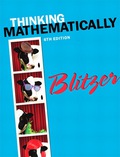
Albert Einstein's theory of general relativity is concerned with the structure, or the geometry, of the universe. In order to describe the universe, Einstein discovered that he needed four variables: three variables to locate an object in space and a fourth variable describing time. This system is known as space-time. Because we are three-dimensional beings, how can we imagine four dimensions? One interesting approach to visualizing four dimensions is to consider an analogy of a two-dimensional being struggling to understand three dimensions. This approach first appeared in a book called Flatland by Edwin Abbott, written around 1884. Flatland describes an entire civilization of beings who are two dimensional, living on a flat plane, unaware of the existence of anything outside their universe. A house in Flatland would look like a blueprint or a line drawing to us. If we were to draw a closed circle around Flatlanders, they would be imprisoned in a cell with no way to see out or escape because there is no way to move up and over the circle. For a two-dimensional being moving only on a plane, the idea of up would be incomprehensible. We could explain that up means moving in a new direction, perpendicular to the two dimensions they know, but it would be similar to telling us we can move in the fourth dimension by traveling perpendicular to our three dimensions.
Group members should obtain copies of or excerpts from Edwin Abbott's Flatland. We especially recommend The Annotated Flatland, Perseus Publishing, 2002, with fascinating commentary by mathematician and author Ian Stewart. Once all group members have read the story, the following questions are offered for group discussion.
a. How does the sphere, the visitor from the third dimension, reflect the same narrow perspective as the Flatlanders?
b. What are some of the sociological problems raised in the story?
c. What happens when we have a certain way of seeing the world that is challenged by coming into contact with something quite different? Be as specific as possible, citing either personal examples or historical examples.
d. How are A. Square's difficulties in visualizing three dimensions similar to those of a three-dimensional dweller trying to visualize four dimensions?
e. How does the author reflect the overt sexism of his time?
f. What "upward not northward" ideas do you hold that. if shared, would result in criticism, rejection, or a fate similar to that of the narrator of Flatlandl?
Want to see the full answer?
Check out a sample textbook solution
Chapter 10 Solutions
EBK THINKING MATHEMATICALLY
- Determine whether the lines L₁ (t) = (-2,3, −1)t + (0,2,-3) and L2 p(s) = (2, −3, 1)s + (-10, 17, -8) intersect. If they do, find the point of intersection.arrow_forwardConvert the line given by the parametric equations y(t) Enter the symmetric equations in alphabetic order. (x(t) = -4+6t = 3-t (z(t) = 5-7t to symmetric equations.arrow_forwardFind the point at which the line (t) = (4, -5,-4)+t(-2, -1,5) intersects the xy plane.arrow_forward
- Find the distance from the point (-9, -3, 0) to the line ä(t) = (−4, 1, −1)t + (0, 1, −3) .arrow_forward1 Find a vector parallel to the line defined by the parametric equations (x(t) = -2t y(t) == 1- 9t z(t) = -1-t Additionally, find a point on the line.arrow_forwardFind the (perpendicular) distance from the line given by the parametric equations (x(t) = 5+9t y(t) = 7t = 2-9t z(t) to the point (-1, 1, −3).arrow_forward
- Let ä(t) = (3,-2,-5)t + (7,−1, 2) and (u) = (5,0, 3)u + (−3,−9,3). Find the acute angle (in degrees) between the lines:arrow_forwardNo chatgpt pls will upvotearrow_forwardA tank initially contains 50 gal of pure water. Brine containing 3 lb of salt per gallon enters the tank at 2 gal/min, and the (perfectly mixed) solution leaves the tank at 3 gal/min. Thus, the tank is empty after exactly 50 min. (a) Find the amount of salt in the tank after t minutes. (b) What is the maximum amount of salt ever in the tank?arrow_forward
- Draw a picture of a normal distribution with mean 70 and standard deviation 5.arrow_forwardWhat do you guess are the standard deviations of the two distributions in the previous example problem?arrow_forward1 What is the area of triangle ABC? 12 60° 60° A D B A 6√√3 square units B 18√3 square units 36√3 square units D 72√3 square unitsarrow_forward
- Algebra & Trigonometry with Analytic GeometryAlgebraISBN:9781133382119Author:SwokowskiPublisher:Cengage
 Linear Algebra: A Modern IntroductionAlgebraISBN:9781285463247Author:David PoolePublisher:Cengage Learning
Linear Algebra: A Modern IntroductionAlgebraISBN:9781285463247Author:David PoolePublisher:Cengage Learning College Algebra (MindTap Course List)AlgebraISBN:9781305652231Author:R. David Gustafson, Jeff HughesPublisher:Cengage Learning
College Algebra (MindTap Course List)AlgebraISBN:9781305652231Author:R. David Gustafson, Jeff HughesPublisher:Cengage Learning  Algebra and Trigonometry (MindTap Course List)AlgebraISBN:9781305071742Author:James Stewart, Lothar Redlin, Saleem WatsonPublisher:Cengage Learning
Algebra and Trigonometry (MindTap Course List)AlgebraISBN:9781305071742Author:James Stewart, Lothar Redlin, Saleem WatsonPublisher:Cengage Learning College AlgebraAlgebraISBN:9781305115545Author:James Stewart, Lothar Redlin, Saleem WatsonPublisher:Cengage Learning
College AlgebraAlgebraISBN:9781305115545Author:James Stewart, Lothar Redlin, Saleem WatsonPublisher:Cengage Learning




